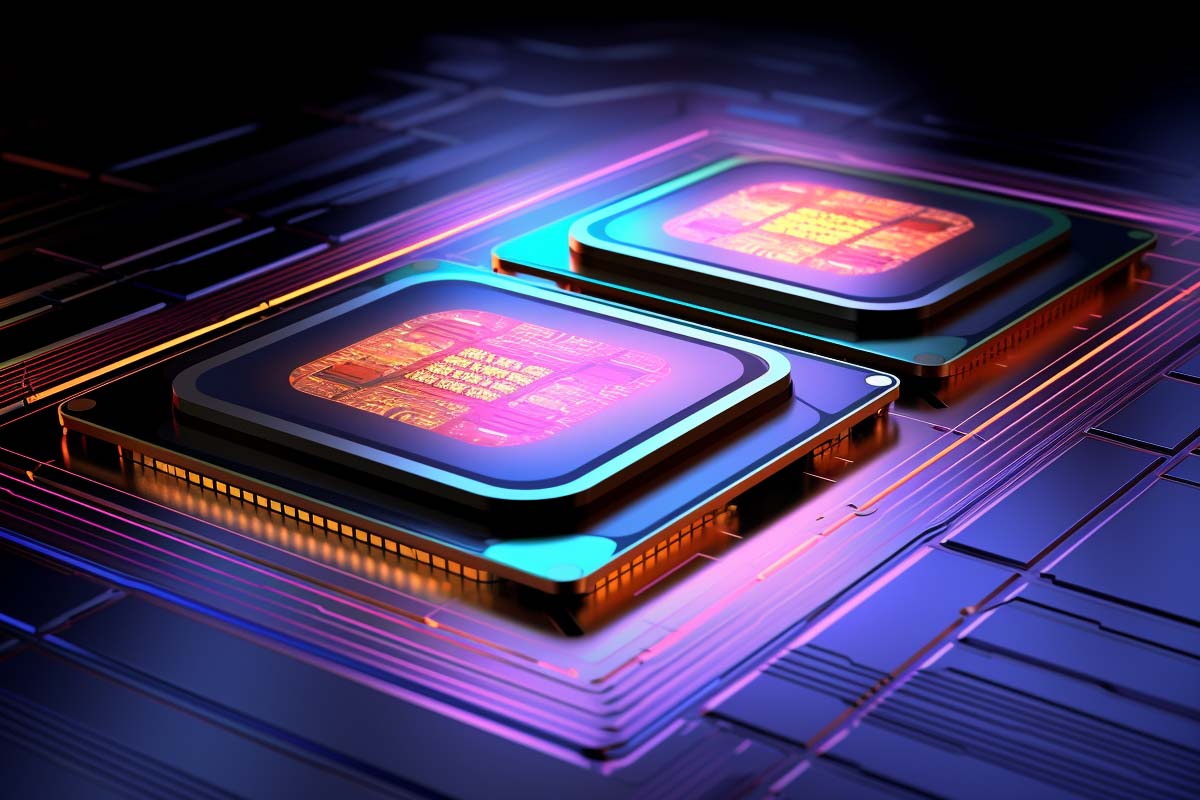Multiprocessor CPUs (MP)
Multiprocessor CPUs, often known as multi-CPU architecture or dual-processor systems, incorporate two or more separate CPUs installed within the same computer, typically on the same motherboard or connected via a high-speed bus system. These CPUs, functioning as a CPU cluster, operate independently but are designed to work in tandem, sharing the same system resources such as memory (RAM) and I/O devices, requiring robust mechanisms for memory access management and data coherence.
Characteristics:
- Multiple CPUs: This setup, also known as Symmetric Multiprocessing (SMP), allows for parallel computing by independently executing different tasks or threads across multiple CPUs.
- Shared Resources: CPUs in a multiprocessor system share memory and I/O devices. This necessitates sophisticated cache coherence protocols and resource allocation strategies to manage memory access efficiently.
- Scalability: Multiprocessor systems can be scaled by adding more CPUs, enhancing their suitability for compute-intensive tasks. However, this scalability comes with increased complexity in inter-processor communication and workload management.
- Cost and Complexity: These systems tend to be more expensive and complex, requiring advanced processor architecture design and maintenance due to the need for intricate hardware and software to manage resources and communication between CPUs.

IT User Support Specialist Career Path
View our comprehensive training series covering all the key elements and certifications needed to successfully excel in an IT User Support Specialist job role.
Multicore CPUs
A multicore CPU, which can range from dual-core to octa-core and beyond, encapsulates multiple execution cores on a single processor chip, enabling parallel data processing and thread-level parallelism (TLP). This design significantly enhances computational speed and efficiency, particularly for parallelizable tasks, while ensuring energy efficiency by sharing the same chip and power supply.
Characteristics:
- Multiple Cores in a Single CPU: Integrating multiple execution cores, such as hexa-core or quad-core, in a single CPU chip, multicore CPUs excel in parallel processing, allowing simultaneous data processing and execution of multiple threads.
- Shared or Separate Cache: Depending on the specific chip design, cores may have individual L1 or L2 caches and share a larger L3 cache, optimizing data retrieval speed and efficiency.
- Energy Efficiency: Multicore CPUs are known for their energy efficiency, reducing heat dissipation and power consumption, crucial factors given the limited silicon real estate and thermal constraints of modern computing devices.
- Ease of Use and Cost: These CPUs are generally more user-friendly and cost-effective than their multiprocessor counterparts, removing the need for complex inter-processor communication mechanisms and simplifying task scheduling and resource management.
Key Differences
- Physical Structure: Multiprocessor systems are characterized by multiple independent CPUs, making them suitable for high-end servers and workstations. In contrast, multicore systems consist of multiple execution cores within a single CPU, ideal for consumer-level computing.
- Resource Sharing: CPUs in a multiprocessor setup share memory and I/O resources, demanding sophisticated management, whereas cores in a multicore system may share caches and are more tightly integrated, minimizing the overhead of resource sharing.
- Performance and Efficiency: Multicore CPUs generally offer better performance per watt by minimizing the distance electrical signals need to travel, crucial in high-performance computing. Conversely, multiprocessor systems can deliver higher overall performance but at the cost of increased power consumption and complexity.
- Scalability: While multiprocessor systems can be scaled with additional CPUs, this leads to heightened complexity and cost. Multicore CPUs are bound by manufacturing capabilities and thermal limits, restricting the number of cores that can be placed on a single chip.
CompTIA ITF+ Training
Ready to kickstart your IT career but don’t know where to begin? Our ITF+ course is your perfect starting point! Master the essential IT skills you need to shine in the tech world. From hardware and software to programming and security, we’ve got it all covered. This comprehensive course is designed to help you ace the CompTIA FC0-U61 IT Fundamentals (ITF+) exam with flying colors.
Multiprocessor or Multicore
The choice between multicore and multiprocessor systems often depends on the specific requirements, workloads, and operational contexts. Below are a few scenarios that illustrate where one might be preferred over the other:
1. High-Performance Computing (HPC) and Scientific Research
- Preferred: Multiprocessor Systems
- Reason: HPC and scientific computations often involve complex simulations, large-scale data analysis, and mathematical computations that require immense computational power. Multiprocessor systems, with their ability to scale by adding more CPUs and their superior capability in handling parallel computing tasks, are typically more suitable for these compute-intensive environments. The high bandwidth interconnects and sophisticated task scheduling mechanisms of multiprocessor systems can significantly reduce the time to complete massive computational tasks.
2. Web and Database Servers
- Preferred: Multiprocessor Systems
- Reason: For servers handling high traffic loads and concurrent requests, such as large-scale web or database servers, multiprocessor systems are often preferable. The ability to handle multiple threads and processes simultaneously ensures that server response times remain minimal even under heavy loads. The scalability of multiprocessor systems is beneficial for expanding computational resources as the demand or workload increases.
3. Everyday Computing and Consumer-Level Workloads
- Preferred: Multicore CPUs
- Reason: For personal computing, such as web browsing, office applications, and even moderate gaming, multicore CPUs are generally more than sufficient. They offer a balanced mix of performance, energy efficiency, and cost-effectiveness. The integrated design of multicore CPUs ensures that tasks like multitasking and media processing are handled efficiently without the complexity and power consumption associated with multiprocessor systems.
4. Mobile Devices and Embedded Systems
- Preferred: Multicore CPUs
- Reason: In mobile devices and embedded systems where energy efficiency, heat dissipation, and space are significant constraints, multicore CPUs are the preferred choice. Their compact design, lower power consumption, and ability to handle multiple tasks simultaneously make them ideal for smartphones, tablets, and other portable devices.
5. Graphics Rendering and Gaming
- Preferred: It depends
- Reason: For graphics rendering, video editing, and gaming, the choice between multicore and multiprocessor systems can depend on the specific requirements and the software’s ability to leverage the hardware. High-end gaming and professional graphics workstations might benefit from multiprocessor systems for their superior raw processing power and memory bandwidth. However, many modern games and graphics applications are optimized for multicore CPUs, making them a cost-effective and powerful choice for most users.
6. Virtualization and Cloud Computing
- Preferred: Multiprocessor Systems
- Reason: In virtualization and cloud computing environments, where multiple virtual machines (VMs) run concurrently, multiprocessor systems offer advantages due to their high scalability and ability to manage extensive parallel processing tasks efficiently. The enhanced performance, when dealing with multiple independent tasks, makes multiprocessor systems suitable for data centers and enterprise-level virtualization needs.
In conclusion, while multicore CPUs are well-suited for energy efficiency, cost-effectiveness, and handling of general-purpose tasks, multiprocessor systems excel in environments that demand high computational power, scalability, and efficient parallel processing capabilities. The choice should align with the specific computational demands, performance requirements, and operational constraints of the intended application.

Free CompTIA ITF+ Training
Embark on an exciting IT journey with CompTIA IT Fundamentals (ITF+) training! Dive into the essentials of hardware, software, programming, and more. This foundational course is your gateway to the IT world, setting the stage for future certifications. Start building your IT career today!
The CPUs Landscape of Options
The landscape of CPUs is diverse, with various offerings tailored to different needs, ranging from personal computing to high-performance servers. Below is an overview of several categories of CPUs, from consumer-level to high-end server processors, along with general insights into their speed and processing capabilities. It’s important to note that the performance of a CPU can depend on various factors including core count, clock speed, thermal design power (TDP), and the specific architecture. The information provided is a general guide and may not include the latest models as of your inquiry.
Consumer-Level CPUs
- Intel Core Series (i3, i5, i7, i9)
- Speed/Power: These CPUs offer a range of capabilities suitable for general computing, gaming, and professional tasks. The i3 series is typically for entry-level, while i9 represents high-end consumer computing, offering higher clock speeds and more cores.
- Use Case: General computing, gaming, content creation.
- AMD Ryzen Series (3, 5, 7, 9)
- Speed/Power: Similar to Intel’s offerings, AMD Ryzen processors provide a spectrum from entry-level (Ryzen 3) to high-performance (Ryzen 9), with increased core counts and clock speeds in the higher tiers.
- Use Case: General use, gaming, and content creation, with particular strength in multi-threaded applications.
High-Performance and Enthusiast CPUs
- Intel Core X-Series and AMD Ryzen Threadripper
- Speed/Power: These CPUs offer higher core counts and are designed for extreme multitasking, content creation, and computational tasks that can utilize the additional cores.
- Use Case: High-end content creation, video editing, 3D rendering, and scientific computations.
Workstation CPUs
- Intel Xeon Series
- Speed/Power: Xeon processors are designed for workstations and servers, offering robust performance, ECC memory support, and high core counts, suitable for demanding applications and multitasking.
- Use Case: Professional workstations, servers, data centers, and complex scientific computations.
- AMD Ryzen Threadripper PRO and AMD EPYC
- Speed/Power: These CPUs offer a significant number of cores and threads, providing immense parallel processing capabilities.
- Use Case: Workstations for 3D rendering, video production, and servers requiring high parallel processing power.
Server CPUs
- Intel Xeon Scalable
- Speed/Power: Designed for scalability, they are ideal for a wide range of server and data center workloads, offering advanced security, high core counts, and significant memory bandwidth.
- Use Case: Data centers, cloud computing, enterprise-level applications.
- AMD EPYC Series
- Speed/Power: Known for high core and thread counts, these CPUs provide substantial computational power for server and data center environments.
- Use Case: Servers, high-performance computing, virtualization, and data-heavy applications.
When evaluating CPUs, it’s important to consider not just the raw speed (GHz) but also the number of cores, the presence of technologies like hyper-threading or simultaneous multithreading, cache size, and how the CPU fits into the overall system architecture, including the motherboard and RAM compatibility. For the most accurate and up-to-date information, it’s recommended to refer to the manufacturer’s specifications and benchmarks from reputable sources.
Key Term Knowledge Base : Key Terms Related to CPUs
When discussing CPUs, multiprocessor, and multicore options, it’s beneficial to be familiar with the following key terms and their definitions:
| Term | Definition |
|---|---|
| CPU (Central Processing Unit) | The primary component of a computer that performs most of the processing inside a computer. It interprets and executes instructions from the computer’s memory. |
| Core | An individual processing unit within a CPU. Modern CPUs can have multiple cores, allowing them to execute multiple processes simultaneously. |
| Multicore CPU | A single CPU that contains two or more cores, enabling it to perform multiple operations simultaneously and independently. |
| Multiprocessor System | A computer system with two or more separate CPUs (processors), which can work independently or together to process instructions. |
| Clock Speed | The speed at which a CPU can execute instructions, typically measured in gigahertz (GHz). Higher clock speeds can indicate faster processing, but efficiency also depends on architecture and other factors. |
| Thread | The smallest sequence of programmed instructions that can be managed independently by an operating system scheduler. Multithreading allows multiple threads to be executed concurrently by a CPU. |
| Cache | A smaller, faster type of memory inside the CPU that stores copies of the data from frequently used main memory locations. There are typically multiple levels of cache (L1, L2, and L3). |
| TDP (Thermal Design Power) | The maximum amount of heat generated by a computer chip or component (often the CPU) that the cooling system is designed to dissipate under any workload. |
| Hyper-Threading / SMT (Simultaneous Multithreading) | Intel’s proprietary technology (Hyper-Threading) and the general term (SMT) for the process where a single physical CPU core appears as two logical cores to the operating system, improving efficiency. |
| Overclocking | The practice of increasing the clock speed of a CPU beyond the manufacturer’s specifications to achieve higher performance, often requiring improved cooling solutions. |
| Socket | The physical interface on a motherboard that allows for the installation of a CPU. Different CPU models may require different socket types. |
| ECC Memory (Error-Correcting Code Memory) | A type of computer data storage that can detect and correct the most common kinds of internal data corruption, often used in servers and workstations for increased reliability. |
Understanding these terms will help facilitate a more informed and productive discussion about CPUs, multiprocessor, and multicore options.
Frequently Asked Questions About CPUs
What is the difference between multicore and multiprocessor systems?
Multicore systems have multiple processing cores within a single CPU chip, allowing them to perform multiple tasks simultaneously within one processor. In contrast, multiprocessor systems consist of two or more separate CPUs that can work independently or together, each having its own processing cores. Multicore systems are generally more energy-efficient and cost-effective, while multiprocessor systems offer higher performance and scalability but at a greater cost and complexity.
How does the number of cores in a CPU affect its performance?
The number of cores in a CPU directly impacts its ability to perform parallel processing. More cores mean the CPU can handle more tasks simultaneously, which can significantly improve performance for multitasking and applications designed to take advantage of multiple cores. However, not all applications benefit equally from additional cores, and some are more dependent on single-core performance or clock speed.
What is the significance of cache memory in a CPU?
Cache memory is a small, fast type of volatile computer memory that provides high-speed data storage for the CPU. It holds frequently accessed data and instructions so the CPU can access this information more quickly than if it had to retrieve it from the main memory (RAM). A larger cache can significantly improve system performance by reducing the time the CPU takes to access data and instructions.
Can I upgrade my CPU to a multicore or multiprocessor system to improve my computer’s performance?
Upgrading to a multicore CPU can improve performance, especially if your applications and workloads can utilize multiple cores. However, upgrading to a multiprocessor system typically involves more than just replacing the CPU—it may require a new motherboard and other components compatible with multiprocessor configurations. Additionally, not all software benefits from multiprocessor systems, so it’s essential to consider your specific needs and whether the software you use can take advantage of the additional processing power.
Is overclocking a CPU safe, and what are the benefits?
Overclocking a CPU can increase its performance by raising its operating frequency beyond the manufacturer’s specifications. However, it also increases power consumption and heat production, which can lead to stability issues or shorten the lifespan of the CPU if not managed properly with adequate cooling and voltage adjustments. It’s essential to understand the risks, have proper cooling solutions in place, and proceed cautiously if you choose to overclock your CPU. The benefits include improved performance in CPU-intensive tasks and potentially better gaming experiences, but it’s not without its risks and should be done by those who understand the process and are aware of the potential consequences.
























